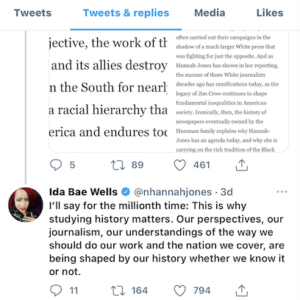By Nyla Scott, Claire Harvey and Phoebe Goebel
Journalists are wrestling with the 100-year-old principle of objectivity within their profession, concerned about truth and power in their stories.
John Watson, an American University professor of law and ethics for 23 years, researches the intersection of ethics, objectivity and diversity in journalism. Watson, who worked in a newsroom for 21 years before that, believes that objectivity doesn’t exist.
“In a real sense I’m saying there is no such thing as objectivity,” Watson said in a Zoom interview Monday. “The simple rules of journalism require you to set aside objectivity and make judgments based on professional, moral and ethical values.”
Objectivity is the longstanding practice of offering two or more sides of a story. Yet, it does not appear in the Society of Professional Journalists Code of Ethics.

The 2016 election of Donald Trump and the Black Lives Matter movement revived and heightened the debate about journalistic objectivity.
Victor Pickard, a professor at the University of Pennsylvania, wrote that modern journalism and its partisanship was a factor in Trump’s rise to the presidency. Pickard wrote in 2016 that Trump received almost three times more news coverage during his campaign compared to Democratic candidate Hillary Clinton.
“Donald Trump’s election exposed structural pathologies in America’s media system,” Pickard wrote.
In his journal article about the origins of objectivity in journalism, Richard Kaplan explained that as journalism and news reporting grew during the 20th century, the news was considered to be objective since reporters were only of one identity: White men.
“Early on in American journalism history the only people who mattered were the white men who owned the new papers and who worked for the newspapers and who edited the newspapers and who made the rules about the newspapers,” Watson said.
As racial representation grew in newsrooms, who has the power to tell stories from diverse communities became more important and furthered the debate about reporters and objectivity. Still, experts including Farai Chideya and Watson have said newsroom diversity is an issue that continues to hurt journalism.
Nikole Hannah-Jones, a The New York Times journalist and creator of the controversial 1619 Project, is fed up with the misrepresentation of people of color and issues of objectivity.
“I’ll say for the millionth time: This is why studying history matters,” Hannah-Jones tweeted. “Our perspectives, our journalism, our understanding of the way we should do our work and the nation we cover are being shaped by our history whether we know it or not.”
Amid the Black Lives Matter movement, journalists have been having a hard time remaining objective.
The Center for Media Engagement, asks, “While journalists are humans just like all of us, the question arises: can the reactions, judgments, and views journalists feel potentially be sources of bias for the stories they cover?”
According to The University of Texas at Austin’s The Center for Media Engagement, reporters such as Michael Santiago, a photographer for the Pittsburgh Post-Gazette who is Black, was prevented from covering Black Lives Matter news by their editors.
The issue of objectivity and its ties to power and storytelling is getting increased attention in college classrooms, according to professor Margot Susca, an expert in journalism and society and assistant professor at American University.
Adriana Doria, 20, a journalism student at American University, explained how she interpreted objectivity as an ongoing process of being transparent when reporting.
“I would define objectivity as telling both sides and seeking the truth at all times,” Doria said.
Gabriel Ferris, 20, another journalism major, emphasized that the best way to reach objective news stories and reports is with fairness and transparency. When asked where he draws the line between giving an opinion and giving hate speech a platform, Ferris explained that most people believe that the world is a 50/50 split, but that is far from the truth.
“The line is fair; it’s being fair,” Ferris said. “It’s about fairness. That’s what it’s all about.”